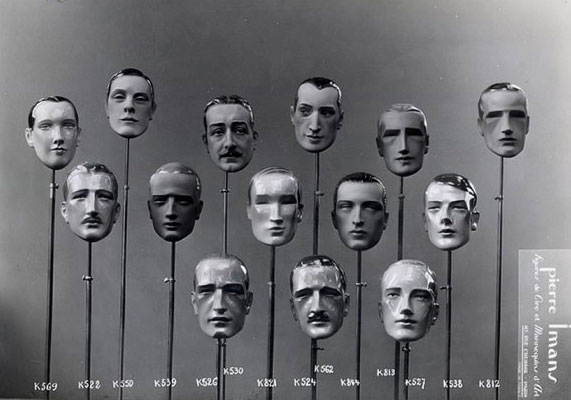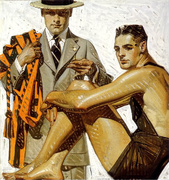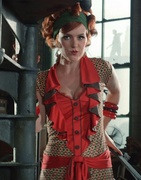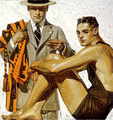
Cynthia’s face remained completely blank, wearing that same empty stare at the theater, Bergdorf’s, a private dinner party, and even her regular hair salon. Everywhere she went, Cynthia tantalized the paparazzi and her adoring public—always seen on the arm of the fashionable Lester Gaba, wearing the runway’s latest styles and enjoying New York nightlife to the fullest—but still her gaze revealed nothing.
Of course, that’s because Cynthia was a mannequin, crafted by Gaba to promote his retail display business. In 1937, Gaba’s irreverent experiment captivated the public by spotlighting our larger fixation with mannequins, made up of a strange blend of adoration, emulation, discomfort, and sometimes even terror. Cynthia was merely the descendant of a long line of mannequins, whose idealized bodies gave shape to our materialist fantasies at least since the time of the Egyptians.
“The female mannequins were very voluptuous, almost like sirens calling them home.”
When archaeologists opened King Tutankhamen’s tomb in 1922, they found a wooden torso bearing the king’s likeness near a chest containing the young pharaoh’s wardrobe, considered the oldest-known forerunner to modern mannequins. This bust was likely used to model Tutankhamen’s elaborate garments and jewelry, providing a stationary figure matching the king’s specific measurements to assist with clothing design and adjustment.
“That would be more like a display form made for tailors and seamstresses, used almost like clothes hangers back then,” says Dr. Marsha Bentley Hale, one of the world’s foremost mannequin experts, who began amassing an extensive archive of research during the 1980s. “Eventually, they became mannequins, the figures that sell fashion.”

Top: Two D.G. Williams papier-mâché mannequins as prepared for Macy’s in the 1940s. Image courtesy ChadMichael Morrisette. Above left, King Tut’s wooden bust. Above right, an early display window for Auerbach’s shows a group of wax mannequins, some with added arms and heads, circa 1909.
Similar to the elaborate fashion dolls that preceded them, retail mannequins were first developed to model the latest clothing styles for wealthy shoppers. The Industrial Revolution generated a surge in mass-produced clothing, requiring new stores with larger shopping spaces in cities across the globe. By the mid-19th century, the garment industry recognized the display form’s potential to make clothing come alive, and with the proliferation of shops—from five-and-dimes to luxury department stores—came an additional market for mannequins.
As Emily and Per Ola d’Aulaire wrote in their overview of mannequin history for Smithsonian Magazine, “Most experts agree that the succession of stages set in motion during the Industrial Revolution—the manufacture of large, steel-framed, plate glass windows, the invention of the sewing machine, the electrification of cities—cleared the way for its arrival. The men and women who strolled the boulevards were the audience; all that was needed were players.” Thus, the familiar pastime of window-shopping was established, and mannequins became central to the drama unfolding on these lighted stages.
Mannequins of the 19th century were mostly glorified dress forms, headless bodies made from wood, leather, wire, and papier-mâché mounted onto heavy iron bases. If they had limbs, their poses were extremely limited, with either both feet together or one stepping forward, arms hanging limply at their sides.

Mannequins in Detroit’s Elliott, Taylor, & Woolfenden department store, circa 1910, show the limited range of early poses and appendages. Image via the Library of Congress.
One of the first companies to offer mannequins with faces was La Vigne, a Paris-based manufacturer that hired a mask-maker to develop papier-mâché heads that could be fitted onto their figures in the mid-19th century. Various suppliers were soon making heads from a mix of materials like papier-mâché, wax, and plaster composition to achieve the most realistic appearance. Many were set with glass eyes and had wigs made from real human hair.
With the shift to full-fledged human figures, mannequins immediately began to reinforce social norms and ideals. “The mannequin figure itself has so much meaning to it,” says Hale. “At the turn of the 19th century, you had bustier mannequins with tiny waists. Suddenly, going into the teens, they got a little more slender. Close to World War II, female mannequins had these broad shoulders. After World War II ended and the soldiers were coming home, all of a sudden the female mannequins were very voluptuous, almost like sirens calling them home.”
Like the larger fashion industry, mannequin design echoes seasonal styles that come and go, both in regard to technological improvements and the way we view our bodies. “It’s often the body attitudes and facial expressions that reflect what’s going on socially,” says Hale. Accordingly, the stiff, unnatural bodies of early mannequins were well-matched for the Victorian Era‘s restrictive ideas about women’s rights and fashions, which dictated they wear many layers of heavy fabric over tight-fitting corsets.

In the early decades of the 20th century, it was easier to deflect criticisms about vulgarity by using partial display forms to model lingerie and corsets, rather than realistic female mannequins.

A drawing for L. Frank Baum’s “Vanishing Lady” gimmick, which drew crowds by rotating a model or mannequin in and out of view.
As their realism increased, mannequins became an easy proxy for larger cultural tensions, especially fears about sexuality and body image. In 1899, a wax figure dubbed “Miss Modesty” made her debut in shop windows, with her arms and hands raised to cover her face in embarrassment, as she was explicitly designed to sell undergarments. Miss Modesty acknowledged her own sex appeal, and made it all the more alluring with her mock shyness.
Around the same time, the Women’s Christian Temperance Union (WCTU), a group supporting the prohibition of alcohol, began pushing for limitations on the spread of such “vulgar” mannequins. Though the WCTU didn’t win its war on the figures, it did inspire some cities to pass laws that required windows be completely covered anytime a mannequin was being undressed.
Before writing the famous “Wizard of Oz” book series, L. Frank Baum edited a display magazine called “The Show Window,” and in 1900, he published a book “The Art of Decorating Dry Goods Windows and Interiors.” Baum advocated the innovative use of mannequins to sell the “romance of Merchandise and Merchandising” by creating scenes that lured customers into a fantasyland. Perhaps unsurprisingly, Hale describes Baum as promoting sexually provocative displays, specifically “advocating a very low neckline,” all in the name of commerce.

By the 1910s and ’20s, mannequins often had articulated limbs, as seen with the La Rosa mannequins at left. Image via larosaitaly.com. Right, Siegel was one of the innovative producers featured at the 1925 International Exposition of Decorative Arts in Paris.
In order to sustain this fictional world, mannequin technology had to keep up with advancements in other fields. Though wax allowed 19th-century sculptors to create highly detailed bodies and facial features, the switch from gas lamps to electric lights exposed the material’s weakness: Under the intense heat of store window light bulbs, wax mannequins began to melt. One window trimmer in the late 19th century recounted the construction of a lovely dinner party scene, centered around a wax hostess raising her wineglass in a toast. When he returned the following morning, a crowd had gathered around the window, staring at the now-deflated hostess whose melted torso was slumped over the table as if she were drunk.
Mannequin suppliers took note of such incidents, and began transitioning to other materials, like papier-mâché and plaster. Simultaneously, the booming middle class meant that more people than ever before had plentiful leisure time, increasing the need for casual attire and sportswear. With women entering the workforce in greater numbers, looser-fitting clothing also showcased trends toward slimmer busts and bare ankles.

This extravagant 1928 window display for Atwater Kent radios shows the heightened realism of many mannequins following World War I. Image via the Library of Congress.
To accommodate such shifts, mannequins became more relaxed, particularly following World War I. Display figures of the era were made with movable limbs that could be positioned in more active, realistic poses. Typically, male mannequins of the early 20th century lagged behind their female counterparts, with blasé expressions on cartoonish faces that appeared to be coated in too much makeup.
As mannequins grew more dynamic in the early decades of the 20th century, designers like Pierre Imans took the genre to new heights, designing sleek modernist figures arranged in unique poses. Imans adopted his aesthetics from the Art Nouveau and Art Deco movements, imbuing the human form with a geometry of smooth, graceful lines. Imans also created some of the first mannequin figures with darker skin tones, including a figure modeled after Josephine Baker that incorporated a head designed by the fashion illustrator Erté.

Left, an Erté illustration entitled “Queen of Sheba,” which was incorporated into a Pierre Imans mannequin modeled after Josephine Baker, seen at right. Photograph courtesy Marsha Bentley Hale.
“At that time, the French and the German mannequins were much more provocative,” explains Hale. “Some of the rare photos in my Pierre Imans collection show mannequins that were made for an exhibit at the Moulin Rouge, called ‘The Streets of Paris,’ which included a lesbian couple—if you can pin sexuality on a mannequin. One was very masculine with short-cropped hair. She did have a skirt on, but her outfit was mostly black, with dark tights or stockings, while the female standing with her was blonde and flirty. That was in the ’20s.”

This selection of chiseled faces by Pierre Imans shows the limited range of emotion on male mannequins, circa 1930s.
Meanwhile, the French company Siegel and Stockman created even more abstracted mannequins, with simplified, geometric features perfectly suited to the popular Art Deco style. “Siegel and Stockman went one step beyond to create mysterious mannequins that resembled aliens with luminescent eyes,” the earliest figures with bald-heads and featureless faces, explained Hale in an article she wrote. Made from papier-mâché and plastic, “their faces and bodies were abbreviated renditions of the human form, with expressions that seemed to mask feelings and retain a certain aloofness.”

Left, Pierre Imans created several subversive figures for the “Streets of Paris” exhibition in the 1920s, including this lesbian couple. Photo courtesy Marsha Bentley Hale. Right, a group of Siegel’s streamlined mannequins from the 1930s.
By 1937, when Lester Gaba created the lifelike Cynthia for his Manhattan publicity stunt, shoppers were familiar with mannequins as abstracted versions of perfection. Gaba later wrote in “The Art of Window Display” that the evening he first brought Cynthia home with him, the famous milliner Lilly Daché stopped by for a visit. Daché was so intrigued by his mute girlfriend that she encouraged Gaba to bring Cynthia to the opening of her new salon the following week.
Gaba’s bizarre experiment eventually garnered enough attention to warrant a spread in Life magazine, and according to Gaba, the scrutiny only dissipated after Cynthia’s plaster body was accidentally smashed to pieces on a trip to the salon. Hale says that Gaba confided he was actually kind of glad she finally met her demise because her public appearances required so much work. In fact, Cynthia was one of many “Gaba Girls” the sculptor had designed for Saks Fifth Avenue, whose thin bodies and regal poses were modeled after real New York socialites, like Cynthia’s namesake, Cynthia Wells.

Left, Cynthia enjoys a cigarette with Lester Gaba at a New York City bar in 1937. Right, Gaba makes a small repair to Cynthia’s upper body. Via www.time.com.
In a similar marketing move a few years later, Bonwit Teller hired several Surrealist artists, like Salvador Dalí, to rework their store windows, underestimating just how provocative they could be. One of Dalí’s windows featured a bathtub lined with Persian lambskin, its darkened water sprinkled with narcissus flowers. Several disembodied arms reached from the water, holding mirrors aimed at a decrepit female mannequin from the late 19th century standing nearby. Her body was clad only in feathers, while her head was topped with a blonde wig crawling with fake bugs and blood-red tears streamed from her eyes. Bonwit Teller quickly replaced the scandalous figure amidst the ensuing public outcry, to which Dalí responded by storming the display and tossing the bathtub right through the plate-glass window.
Despite this eccentric performance, the World War II era generally embodied a return to somber mannequins wearing the restrained fashions of the time and doing their part to support our boys fighting in Europe. Wartime also brought material advancements, and in the 1940s, Wolf & Vine (now called Greneker) became the first company to release a completely plastic mannequin. To the company’s dismay, the extreme conditions of display windows caused a chemical reaction in the new material, turning the mannequins a greenish color. Even after spending around $100,000 to develop this plastic model, Wolf & Vine was forced to take it off the market.

Dalí wasn’t the only Surrealist inspired by mannequins, as these two images from the 1938 International Exposition of Surrealism in Paris show. At left, André Breton’s chest with legs, and at right, Sonia Mossé’s altered mannequin.
It wasn’t long before other companies had created their own plastic mannequins, and along with this new material, the postwar period “brought a siege of ‘happy-go-lucky’ and relaxed men, in fact, so much so that one was even yawning,” according to Hale. Though fun was back in style, sexuality was not: Hale says that during the 1940s and ’50s, American companies had to sand the nipples off of older mannequins that were deemed too overtly sexual.
By the 1960s, fiberglass had become the industry standard, offering a lighter and sturdier alternative to plaster or plastics. In synch with the changing beauty standards of the sexual revolution, both male and female mannequins began to express a more realistic physicality. Broad chests and muscles appeared on men, while for women, nipples returned as the braless look came into vogue.
Heading into the supermodel era, mannequin faces were increasingly based on recognizable celebrities, like Adel Rootstein’s famous Twiggy mannequin. Los Angeles-based display designer ChadMichael Morrisette calls Twiggy the “holy grail” of vintage mannequins, since only around seven are known to exist. “She was made in ’67 or ’68, when Twiggy was just 18,” Morrisette explains. “Everyone is knocked over when they see how small she is—like five foot five. Twiggy was a teen sensation at the time, so she was made as a junior mannequin.”

Left, the real Twiggy poses in front of a Rootstein display, and right, Morrisette’s very own Twiggy. Photo at right courtesy ChadMichael Morrisette.
In the 1960s, Adel Rootstein also created one of the few non-white figures of the period, based on the American model Donyale Luna. But Hale believes Rootstein’s most popular design was the Sayoko mannequin from the 1970s, designed after the Japanese model Sayoko Yamaguchi. “Sayoko is the one that they call the 10, the one that people universally think is exquisite,” she says.
Throughout the 1970s and ‘80s, most mannequins became increasingly abstracted, leading to the ubiquitous faceless, or sometimes headless, figures of the ‘90s typically painted in solid white, black, or grey tones. In 2000, Hale published a series of articles called “The Cloning of Mannequins in the Year 2000,” which documented the shift from varied expressions and body types to identical groups of faceless mannequins. “Everybody calls them ‘futuristic’ or ‘modern,’” says Morrisette, “but they’ve been using them since the ’70s. They lack any unique physical characteristics, and the absolute worst are the headless varieties.”

Two catalog images from the 1970s showing Rootstein’s Sayoko mannequin, a collector favorite.
For his own work, Morrisette prefers realistic mannequins with distinctive facial features and poses, which have typically been sculpted from living individuals, whether or not they were famous. “Everyone laughs at me when I say, ‘Let’s go get Arlene,’ or ‘I just got an Alexandra,’ but that was the name of the model, and that’s how it’s sold,” says Morrisette. “The faces are all based on real people, and have been for a very long time.”
Like many devoted to mannequins, Hale is particularly fascinated by their reflection of social history. Perhaps the most significant artifacts in Hale’s archive are her many photographs of store displays from places like Paris, London, New York, and Los Angeles. “The photos go from the 1910s into the ’80s, and they capture this whole social history. It’s not just about the mannequins themselves, but the world they inhabited: Maybe one window will be asking people to buy war bonds during World War II, or showing the development of the washing machine or some other technology.”
During the 1980s, Hale was the world’s most visible champion of mannequin history, lecturing on their evolution while building her personal collection, which she hoped would someday be housed in a permanent museum. Her plans for a public collection thwarted, Hale now hopes to take advantage of new technology to establish a digital archive of mannequin history. “I worked with the costume division of the Smithsonian Institution as a consultant, and there was a possibility that they were going to put together a collection of 100 American mannequins, but the project didn’t pan out,” she says. “There have been other false leads, but at this point, I think the best way to deal with a mannequin collection is to make a virtual mannequin museum, one that’s online.”

Left, Hale had this letterhead designed by Richard Carciero to showcase the historical shifts in mannequin forms. Right, Hale followed in Gaba’s footsteps and brought a tuxedo-clad mannequin as her date to Ron Rezek’s Halloween party in the 1980s. Images courtesy Marsha Bentley Hale.
In contrast, Morrisette learned the ins and outs of mannequin manufacturing from his experience with retail merchandising. His foray into the world of vintage mannequins actually began at the peak of the faceless clone trend: In the late 1990s, as he moved up the merchandising ranks at department stores like Nordstrom and Saks Fifth Avenue, Morrisette was encouraged to learn about vintage mannequins by his friend and colleague, Michael Zadowicz, who was the lead sculptor at Patina V, a major mannequin manufacturer near Los Angeles.
Since then, Morrisette has taken up the mantle from Hale, acquiring more than 400 vintage mannequins, along with historic catalogs, photographs, and other related ephemera. In addition to his display business, CM Squared Designs, Morrisette is also working on a retrospective exhibition with the mannequin manufacturer Pucci.

Morrisette prefers realistic mannequins in dynamic poses from all eras, which he mixes together for dynamic displays like this store window for the L.A. boutique Madison. Photo courtesy ChadMichael Morrisette.
When designing his retail displays, Morrisette only uses mannequins from his own collection, working to educate clients about the variety of postures and attitudes. “They’re still very much stuck on that disgusting trend of the headless or egghead, white, homogenized clones. But in my personal work, I always use realism,” says Morrisette. Most of Morrisette’s clients are independent boutiques with only a few locations, allowing him to incorporate figures from many different eras, all restored to look like new.
“I seek poses that are interesting. I want them interacting with furniture; I want their arms up; I want them leaning on each other. I want poses that help me tell my stories, and the vintage ones are the best for that. We’re just not making many of those mannequins anymore. Visual display has turned into a corporate, cookie-cutter kind of reality.”
But working with vintage mannequins comes with its own complications, particularly the difficulty of locating figures without significant damage. “If they’re missing a finger or two, I’ll make an exception. But if they’re missing a hand, I won’t even buy them,” Morrisette says. “However, if you find a complete hand with all of its fingers made by one of the older companies, it’s like finding a golden nugget.”

Morrisette says vintage mannequin hands are the hardest parts to find intact. Above, a few treasures from his collection. Photo courtesy ChadMichael Morrisette.
Depending on the quality or history of a particular mannequin, Morrisette will either make repairs himself or take it to a company like Patina V for a full restoration. “If they’re in very good shape, I’ll keep their original face paint,” says Morrisette, “but if not, I try and photograph them as I bought them so I have a record of what the skin tone or eye makeup was.”
Once they’ve been refurbished and repainted, Morrisette says that his clients have no idea what period the mannequins are from, allowing him to use a variety of looks in a single display. “I like to mix up the makers and the decades, but you can’t put one from the ’50s, ’60s, or early ’70s next to one from the ’80s or later because there was an obvious shift in design. The human form was waspy and girdled in the ’50s and ’60s, but in the ’80s they started doing really realistic backbones and bellybuttons and things that weren’t made before. So there’s a difference in the sculpt.”

A bit of paint makes a world of difference, as seen in these before and after shots of a vintage mannequin refurbished by David of Dash-N-Dazzle.
As Morrisette looks to the future of mannequin production, he predicts that the most significant changes will have less to do with body type and more with our growing environmental awareness. “Right now, there’s a shift happening away from fiberglass, and seeing how toxic and un-environmentally friendly it is, companies are trying to use better technologies. Greneker makes one model out of a soy-based plastic to try and be more green. Within the next 10 years, I don’t think mannequins will be made of fiberglass anymore, and they shouldn’t be, honestly. They end up in landfills and don’t ever disintegrate. It’s a toxic material, so if we can come up with something better, we should.”
Regardless of such physical changes, Morrisette believes the power of mannequins and the fantasy worlds they inhabit will hold strong. “I think there’s a pastime of window shopping rooted in our psyche, not just buying things, but walking down the street and looking at them. Everybody in New York goes to see the Christmas windows, but does everybody go into those stores and shop? I can’t afford Bergdorf, but I still go and look at their windows. We like to see these products, and not just online: We want to look at them in person, and dream about them.”
(For more vintage mannequins, explore ChadMichael Morrisette’s full mannequin collection on his flickr or the retro makeovers of Dash-N-Dazzle.)


 Before Rockwell, a Gay Artist Defined the Perfect American Male
Before Rockwell, a Gay Artist Defined the Perfect American Male
 Black Is Beautiful: Why Black Dolls Matter
Black Is Beautiful: Why Black Dolls Matter Before Rockwell, a Gay Artist Defined the Perfect American Male
Before Rockwell, a Gay Artist Defined the Perfect American Male Did Hollywood Give the 1920s a Boob Job? 'Gatsby' Costume Designer Tells All
Did Hollywood Give the 1920s a Boob Job? 'Gatsby' Costume Designer Tells All Store DisplaysFrom lighted glass cabinets to simple cardboard signs, in-store displays ha…
Store DisplaysFrom lighted glass cabinets to simple cardboard signs, in-store displays ha… Mari Tepper: Laying it on the Line
Mari Tepper: Laying it on the Line Nice Ice: Valerie Hammond on the Genteel Charm of Vintage Canadian Costume Jewelry
Nice Ice: Valerie Hammond on the Genteel Charm of Vintage Canadian Costume Jewelry How Jim Heimann Got Crazy for California Architecture
How Jim Heimann Got Crazy for California Architecture Modernist Man: Jock Peters May Be the Most Influential Architect You've Never Heard Of
Modernist Man: Jock Peters May Be the Most Influential Architect You've Never Heard Of Meet Cute: Were Kokeshi Dolls the Models for Hello Kitty, Pokemon, and Be@rbrick?
Meet Cute: Were Kokeshi Dolls the Models for Hello Kitty, Pokemon, and Be@rbrick? When the King of Comedy Posters Set His Surreal Sights on the World of Rock 'n' Roll
When the King of Comedy Posters Set His Surreal Sights on the World of Rock 'n' Roll How One Artist Makes New Art From Old Coloring Books and Found Photos
How One Artist Makes New Art From Old Coloring Books and Found Photos Say Cheese! How Bad Photography Has Changed Our Definition of Good Pictures
Say Cheese! How Bad Photography Has Changed Our Definition of Good Pictures Middle Earthenware: One Family's Quest to Reclaim Its Place in British Pottery History
Middle Earthenware: One Family's Quest to Reclaim Its Place in British Pottery History Fancy Fowl: How an Evil Sea Captain and a Beloved Queen Made the World Crave KFC
Fancy Fowl: How an Evil Sea Captain and a Beloved Queen Made the World Crave KFC
My girlfriend is a training manager for a women’s clothing chain…she likens dressing the mannequins to playing with dolls.
It’s so nice to read about Lester Gaba. I grew up thinking he was just one of “the boys” in my art dealer grandmothers entourage we would visit with on Fire Island. I had no idea of his fame 40 years prior. I just knew him for his still lives.
Congratulations! You’ve just helped me discover a new interest/fascination. What a story these figures can tell.
Thanks for this great research. Many great pictures and stories to check out. I have to look at my old 1960’s? manikin from Omaha now and figure out who she is.
I’m looking for recommendations on how to find a artist in the 1920’s to 1940’s. His name is Thomas Clifford Lannin. My cousin has about 14 photograph’s taken by Worsinger Window Services at several major stores like Lord and Taylor, Macy’s, others. I was in Thomas Clifford Lannin’s Portfolio. I cannot find any thing about him. Any recommendations on where to start would be greatly appreciated. Take Care
Does anyone have any info on a mannequin with FLAIB New York 11 means?
Can anyone tell me about “Graceful Mannequin Co. INC. This is the stamp on the lower half waist along with 101 and 509/101. I believe this is a plaster mannequin.
In regard to the people trying to identify their own mannequin or mannequins. Or If you have questions about your vintage mannequin or your looking for information on mannequins try the facebook page “Vintage mannequin”. There are over 800 members currently made up with people looking for information, collectors and professional visual stylist from Japan to California. There are a huge amount of members who can answer any questions or help you with identifying mannequins and what decade they are from. They also post vintage mannequins for sale. Its a great place to check out and the photographs from different decades are amazing.
In 1988 I donated a damaged (circa 1920’s) wax mannequin head to Marsha Bentley Hale within a year of her opening “The Mannequin Museum”. I wondered if she was ever repaired and if “she” is displayed in her museum. The Mannequin her was named “Elizabeth”. I am in hopes she survived, Thank you.
Nice well written article Hunter ! We miss you
Loved this article, brought back many fond memories.
I worked for a few years at the Cincinnati Elder-Beerman (circa 1979-1981) store on Fountain Square, the former downtown flagship for Mabley & Carew. The non-public 10th floor was almost entirely for display (along with a sadly by then defunct custom sign and prop fabrication shop) and was a treasure trove of mannequins from early 1960s forward (possibly even a few from slightly earlier that migrated from the previous nearby location). Included among many of these sadly neglected beauties was a single, perfect Rootstein Sayoko (exact same pose as the one at right shown above) which we rescued from storage obscurity and pressed back into service in a standalone window next to the side entrance on Vine, so the world could once again gaze upon her beauty. She was by far and above my favorite mannequin in the entire store.
We also had a number of startling yet quite compelling glass-eyed Greneker models in the dress department, an odd Hindsgaul and Decter here and there, with the main windows on 5th populated by the newest models, a stunning fleet of D. G. Williams beauties, all of which I ended up repurchasing later when I was display director of my own store.
Thanks for the fun trip down memory lane.
Excellent article by Hunter ! Sad he is gone from CW .